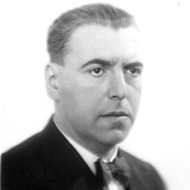Schulhoff Erwin
- Year of Birth - Death :
- 1894 - 1942
Biography
Ervin Schulhoff came from a Prague well-to-do Jewish-German family. Even though his parents were not musical themselves, they wholeheartedly supported and encouraged their son' s talent. He commenced his musical studies at the Prague Conservatory of Music, continued them in Vienna and Leipzig (where his composition teacher was Max Reger) and completed them successfully in Cologne. In the early days of his career, Schulhoff' s most favourite composers included Reger, Strauss, Debussy and to some extent Skriabin. But the promising start of his career as a composer and pianist was interrupted by the outbreak of the First World War, a period which Schulhoff spent as a soldier mostly on the eastern front. His wartime experiences completely changed his vision of the world and of art. During his stay in postwar Germany (1919-1923), Schulhoff joined the ranks of the left-wing avant-garde, while helping to shape its views as a composer. He was particularly attracted by the Berlin Dadaism of painters Grosz and Dix, to whose art Schulhoff responded by utilizing jazz as an instrument for increasing that provocative distance that divided the avant-garde on the one hand and the power elite and its culture on the other. Picturesques for Piano (1919), dedicated to Grosz, was his first jazz cycle, which was eventually followed by a number of other compositions for various instruments up to the jazz oratorio H. M. S. Royal Oak (1930) . The antithesis of those interests of Schulhoff may be found in the Schonberg school. The opening atonal movement of his string S e x t e t (1920-24) demonstrates Schulhoff' s complete, albeit temporary identification with the radicalism of that school. But Schulhoff did not remain indifferent to the challenge of Stravinsky either, as is shown - for instance - in the three other movements of the same Sexted composed four years later. Such an oscillation between expressionism and neoclassicisin is typical of not only this particular work but also nf many other compositions which Schulhoff wrote between the time of his arrival in Prague (in November 1923) up to about the early 1930s. In fact, this was the composer' s most prolific period during which he managed to fuse stimuli of West European modernism, in particular German and French modernism, with the d folklorism of Slavonic origin. Schulhoff's style acquired some specific traits then, while a number of his works attracted justified attention (eg. String Quartet No 1 - 1924, Piano S o n a t a s from the years 1924-27, Symphony No.l-1925, Double Concerto for Flute, Piano and Orchestra -1927, ballet The Sleep-walker -1925 and many others). A special position is occupied in Schulhoff' s works by his Concerto for String Ouartet and W i n d O r c h e s t r a (1930), which - owing to its austerity of expression and consistent constructivism - paved the way for a new phase in Schulhoff's creativity. But the composer decided not to follow that line. Influenced by the aesthetics of proletarian art, he assumed a totally critical, indeed negative, view of his previous works, rejecting out of hand everything that belonged to "the arsenal of the degenerated bourgeois art" according to this aesthetic, eventually beginning to write flat and unimaginative transparent music. In his cantata M a n i f e s t o (1932-33] Schulhoff still considered using a non-traditional form but in his subsequent symphonies (from the Third to the Sixth between 1935 and 1942) he completely espoused and adopted the conservative doctrine of socialist art, which eventually brought him into conflict with his own talent. After that, Schulhoff never found his way out of his artistic predicament. Following the tragic events of the 1938-39 period he was thinking of settling down in the Soviet Union, even obtaining Soviet citizenship but he could not make up his mind quickly enough. After Germany's attack on the Soviet Union in World War II, he was arrested and imprisoned first in Prague and later in the Wulzburg camp, where he died of tuberculosis after about a one-year of inprisonment. At the time his death Schulhoff was sketching his Eighth Symphony.
© 2012-2025 Musicbase.cz
Webdesign & hosting Nux Ltd.
Information about web | Sitemap | RSS | Statistics | CMS
Contact information
Music information center, o.p.s.
tel: 257 312 422 | e-mail: his@musica.cz

